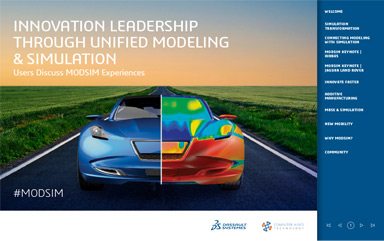
Cadence launches Millennium M1, an HPC-powered GPU-accelerated CFD system. (Image courtesy of Cadence)
Latest News
February 1, 2024
Today, Cadence Design Systems (Cadence) launches Cadence Millennium Enterprise Multiphysics, an HPC-powered CFD simulation system. The company describes the first incarnation of the product, called M1, as “the industry’s first turnkey CFD solution.” It explains, “Available in the cloud or on premises, this turnkey solution includes graphics processing units (GPUs) from leading providers, extremely fast interconnections and an enhanced Cadence high-fidelity CFD software stack optimized for GPU acceleration and generative AI.”
Millenium M1 is part of the Cadence's multiphysics systems analysis portfolio. The company began as an EDA (Electronics Design Automation) software maker, but expanded into CFD with various acquisitions. With M1, the company is targeting the automotive, aerospace and defense, energy, and turbomachinery industries, where large scale simulation is a regular feature of the design and valication programs.
According to Frank Ham, VP of CFD R&D at Cadence, the core of the CFD software in M1 is Cadence Fidelity LES (Large Eddy Simulation), a solver from a company called Cascade that Cadence acquired in 2022. “This particular solver has been built from the ground up for high-fidelity flow simulation to run on GPUs,” says Ham.
Customers may choose to get the solution bundled with on-premise hardware, or with remote access to HPC managed by Cadence. On-premise hardware is configurable per rack (32 GPUs per rack). Cloud HPC price is calculated per node (8 GPUs per node), billed per quarter.
Alexander Gatzemeier, Product Management Director at Cadence, notes, “Some companies prefer to keep data onsite, even though there are many companies that are now migrating their workload to the cloud. So we want to meet all our customers' business requirements.”
Cadence is also promoting Millenium M1 as “an accelerated digital twin solution for multiphysics system design and analysis.” As a digital twin solution, Ham says, “This is for chewing through the numbers, for delivering physics at scale. It complements digital twin visualization products like NVIDIA's Omniverse.”
More Cadence Coverage
Subscribe to our FREE magazine, FREE email newsletters or both!
Latest News
About the Author
Kenneth Wong is Digital Engineering’s resident blogger and senior editor. Email him at [email protected] or share your thoughts on this article at digitaleng.news/facebook.
Follow DERelated Topics






